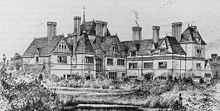Shotwick House
| Shotwick House | |
|---|---|
 The entrance front of Shotwick Park in about 1879 | |
| Location | Great Saughall, Cheshire, England |
| Coordinates | Coordinates: 53°13′32″N 2°57′47″W / 53.2256°N 2.9631°W |
| OS grid reference | SJ 358 702 |
| Built | 1872 |
| Built for | Horace Dormer Trelawney |
| Rebuilt | 1907 |
| Restored by | Thorneycroft Vernon |
| Architect | John Douglas |
| Architectural style(s) | Neo-Elizabethan |
Listed Building – Grade II | |
| Designated | 10 October 1985 |
| Reference No. | 1115438 |
 Location in Cheshire
| |
Shotwick House (originally known as Shotwick Park) is a large house in Great Saughall, Cheshire, England. It is designated by English Heritage as a Grade II listed building.[1]
History
The house was built in 1872 for Horace Dormer Trelawny and designed by the Chester architect John Douglas.[2] In 1907 it was damaged by fire and following this it was rebuilt and extended, the architect again being John Douglas; at this time the owner was Thorneycroft Vernon.[3] In the later part of the 20th century it was in use as a nursing home.[1][4] Its stable courtyard, also designed by John Douglas, is listed at Grade II.[5]
Architecture
Shotwick Park is built in brick with a tiled roof in neo-Elizabethan style.[6] The main front has seven bays with each external bay forming a turret; the turret on the left is larger and higher than that on the right. Both turrets are polygonal in shape, each with a pyramidal roof having a lead finial and a weather vane. The front has two storeys, other than the left turret that has three storeys. The central bay projects forwards and is canted. The roofs are steeply-sloping and are hipped; over each of the central five bays is a hipped gable. Tall chimneys rise from the roofs.[1]
The architectural historian Nikolaus Pevsner in the Buildings of England series describes it as a "fine" house.[6] In Douglas' biography, Edward Hubbard refers to its "massive solidity and indefinable form, its heavy hipped and gabled roofs and its elaborate use of brick".[7] The architectural writers Figueirdo and Treuherz comment that the house "is an effective composition from a distance, but close to, the detailing is dull".[4]
See also
References
Citations
- ↑ 1.0 1.1 1.2 English Heritage, "Shotwick House, Saughall (1115438)", National Heritage List for England, retrieved 1 August 2012
- ↑ Hubbard 1991, p. 243
- ↑ Hubbard 1991, p. 275
- ↑ 4.0 4.1 de Figueiredo & Treuherz 1988, p. 270
- ↑ English Heritage, "Stable courtyard at Shotwick House, Saughall (1330285)", National Heritage List for England, retrieved 1 August 2012
- ↑ 6.0 6.1 Pevsner & Hubbard 2003, p. 229
- ↑ Hubbard 1991, p. 115
Sources
- de Figueiredo, Peter; Treuherz, Julian (1988), Cheshire Country Houses, Chichester: Phillimore, ISBN 0-85033-655-4
- Hubbard, Edward (1991), The Work of John Douglas, London: The Victorian Society, ISBN 0-901657-16-6
- Pevsner, Nikolaus; Hubbard, Edward (2003) [1971], Cheshire, The Buildings of England, New Haven and London: Yale University Press, ISBN 0-300-09588-0